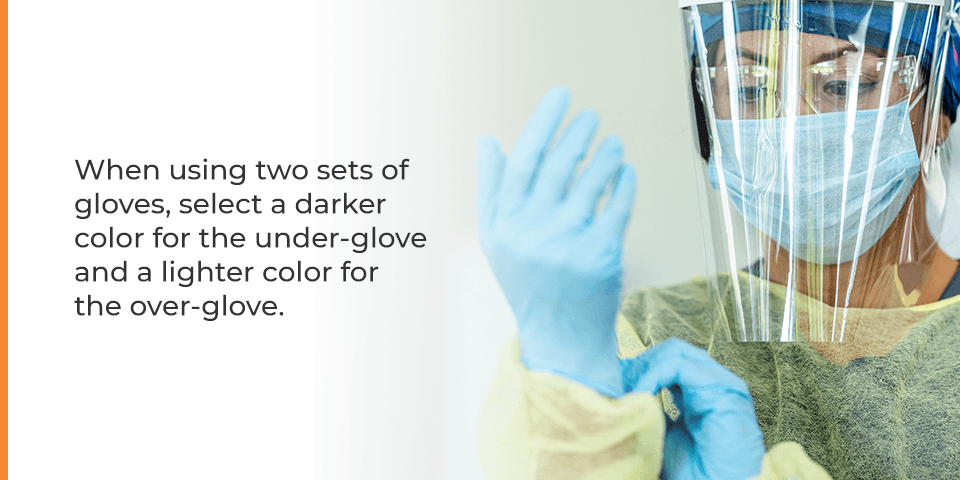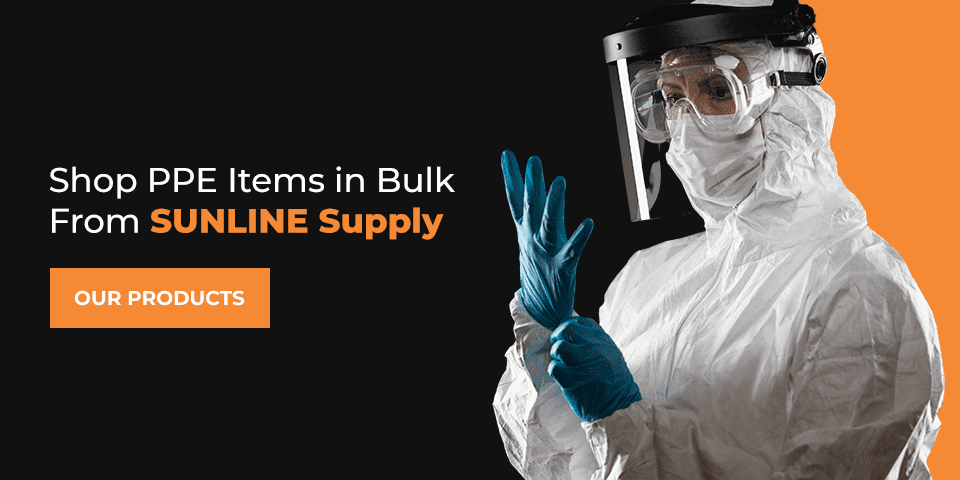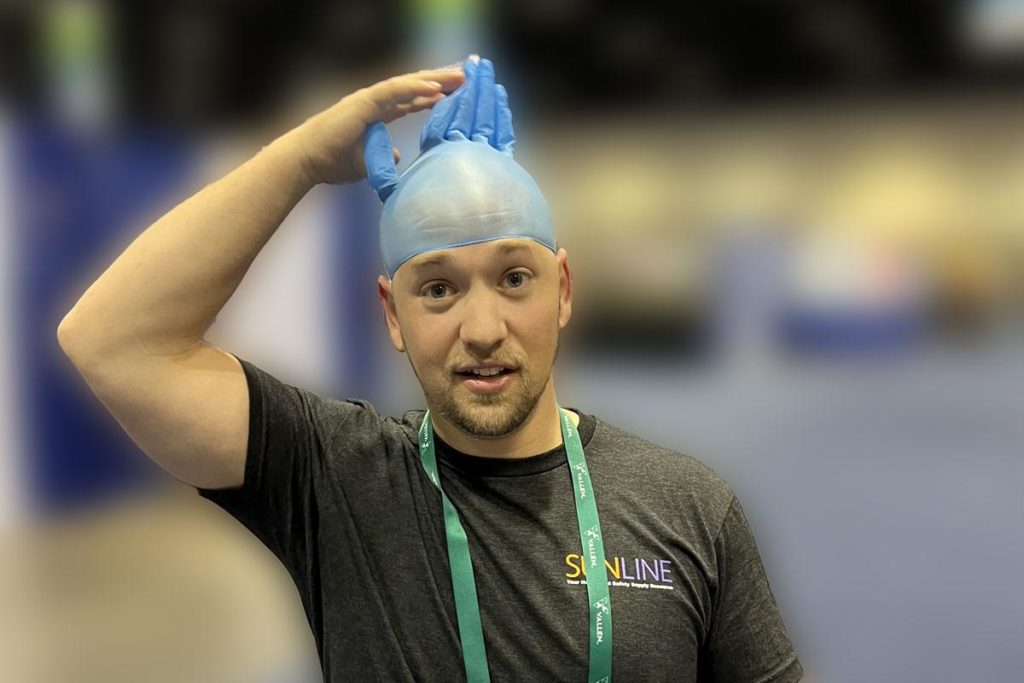
Properly Donning and Doffing PPE
Personal protective equipment (PPE) are products intended to protect the wearer against germs and viruses. For medical purposes, proper use of PPE can minimize germ spreading, reduce the risk of infection in healthcare providers and prevent dangerous exposure to other patients. However, these protection products are only effective when used appropriately.
PPE is an umbrella term for products such as gloves, face masks, face shields, medical gowns, isolation suits, goggles and other items intended for protective use. The meaning of donning and doffing refers to how you put on and remove PPE. The donning process facilitates the correct application of PPE while doffing procedures ensure safe removal after the wearer has concluded an encounter with potential contaminants.
Properly donning and doffing PPE is critical for reducing the risk of contamination. Workers should use PPE alongside other infection control methods to mitigate infection spread. It’s paramount for healthcare provides to become proficient in donning and doffing the PPE available to them, as improved knowledge and appropriate techniques will ensure safety and effectiveness.
Necessary PPE Items
It’s crucial to check that your PPE is the correct size. In most procedures, healthcare providers will protect themselves with the following PPE products:
- Foot covers: Boot covers or shoe covers provide a fast and straightforward solution for entering hazardous areas without risking contamination upon exit.
- Gowns and suits: approved gowns offer varying levels of protection against different risks. Gowns should fully cover the wearer’s torso from neck to knees and their arms to the end of their wrists, fastening at the back of the neck and waist. Isolation suits provide suitable protection for all four levels of risk and come in one-pieces or two-pieces.
- Hair caps: Hair caps prevent hair from contaminating a sterile work area or susceptible surfaces.
- Face shields and eye protection: For a face shield to be effective, it must limit exposure to aerosols and other bodily fluids. Face shields should fit without fogging and impacting the wearer’s vision. If the wearer uses prescription glasses, they may need protective goggles instead. Healthcare providers should be able to comfortably wear face shields and other eye protection for extended periods.
- Respirators: Respirators should fit snug to the face and below the chin. Secure the respirator straps at the crown of the head and base of the neck. The flexible band should fit flush to the nose bridge.
- Face Masks: Face masks with ties should be secured at the crown of the head and base of the neck. Face masks with loops should hook appropriately around the ears.
- Gloves: Medical gloves should extend to cover wrists. Disposable gloves are often available in various sizes, including small, medium, large and extra-large.
Workers, especially healthcare providers, must know how to don and doff PPE items of various types. Each item may have individual practices and techniques for donning and duffing they need to follow. Ensure safe PPE use and removal with an effective procedure for putting on and taking off all PPE items.
Proper Donning Procedures
A contamination-free changing room is necessary for workers to safely and effectively don their PPE. This room should be kept away from the rest of the workplace and facilitate the appropriate donning procedures. Adjust the donning method according to the specific application or environment.
One example of proper procedures for donning PPE may include the following steps:
- Always start with clean hands. Before donning any PPE items, wash your hands and sanitize for 20 seconds.
- Put on foot covers if required. While seated, carefully don protective foot covers over your footwear. Secure the shoe covers close to the foot, so there are no gaps.
- Put on a clean, appropriately fitted gown or suit. Ensure all ties are secure — you may need assistance from another worker to secure the ties.
- Put on a hair cap if required. Certain operations may require hair covering. Ensure the hair cap is secure and all hair is protected inside.
- Put on a NIOSH-approved respirator or face mask. Select an appropriately sized respirator, though you can use a face mask if respirators are not available. Don your face-covering to meet the manufacturer’s recommendations with both your mouth and nose protected.
- Put on a face shield, goggles or other eye protection. Don your face shield. If eye protection is required for workers instead, ensure they fit comfortably with no gaps.
- Re-sanitize hands. Perform hand hygiene, then promptly don your gloves. Before performing this final sanitization, you should don all other PPE aside from gloves.
- Put on appropriately fitted gloves. Gloves should cover the cuff of your gown, ensuring adequate protection for your wrists and hands. In specific applications, gloves may need to cover higher up your sleeves as well.
- Confirm the PPE is correct. Have another worker check the equipment to ensure it’s right, with all gaps and openings covered. Healthcare providers may enter the patient room at this point.
Proper Doffing Procedures
Establishing proper doffing procedures is critical for healthcare facilities and companies that handle potential contaminants. Taking off — or doffing — PPE should be a careful and deliberate process, minimizing the risk of accidental cross-contamination. Workers must take precautions with every point of contact they make. Avoid touching any contaminated surfaces when wearing the PPE.
An example procedure for doffing PPE may consist of the following steps:
- Find a safe place to remove PPE. Healthcare providers should remove certain PPE products while they are still inside the patient’s room. Gloves and gowns, in particular, need doffing before exiting.
- Carefully remove gloves. During glove removal, it’s vital to avoid contact between the outside of the gloves and your un-gloved hands.
- Sanitize hands for 20 seconds. Perform hand hygiene throughout the process, especially after removing gloves.
- Remove gown or suit. Avoid forceful movements while doffing gowns and suits as they can free the hazardous substance or infectious particles from the surface. Starting at the shoulders, roll the gown down over your arms and away from the body. Fold or roll the gown into a bundle while holding it by the non-contaminated inner surface. Dispose of the gown or suit in an appropriate waste receptacle before leaving the room.
- Re-sanitize hands. You’ll need to perform hand hygiene throughout the doffing process. Re-sanitize hands before exiting the patient’s room or immediately after.
- Remove face shield, goggles or other eye protection. Carefully grab the strap of your face shield or eye protection. Then, pull the strap upwards and away from the head without touching the front surface of the PPE. Place these items in a designated container for reprocessing or an appropriate waste receptacle.
- Remove face mask or respirator. Avoid touching the external front surface of the respirator or face mask while doffing. Instead, use the elastic headpieces for safe removal.
- Discard face mask or respirator. Continue avoiding contact with the front of your mask or respirator. Dispose of the PPE in an appropriate waste receptacle.
- Re-sanitize hands. After doffing the last PPE, perform hand hygiene by washing hands with soap and water for 20 seconds.

Doffing Double Gloves
When using two sets of gloves, select a darker color for the under-glove and a lighter color for the over-glove. This method of layering will help identify breaks and tears in the top layer.
Limit skin exposure and don both gloves so that they extend over the gown cuff. To aid in doffing, position the under-glove higher on the gown’s sleeve than the top layer. If available, use a longer glove style for the first layer to make this distinction more effective. The over-glove may need to be one size larger to aid in donning.
Doffing Gloves: A Safe Removal Technique
When doffing two layers of gloves, workers can adopt a variation of a glove-to-glove, skin-to-skin technique used for standard glove removal. You want to remove one glove at a time, even when wearing multiple sets.
One method for doffing double gloves includes the following steps:
- Grab the outside of the first over-glove by pinching near the palm.
- Pull the glove down and off fingers, turning it inside out as it comes off.
- Wad the removed glove into a ball and hold it in the remaining double-gloved hand.
- Remove the second over-glove in the same manner as the first. The first over-glove should be turned inside of the second glove as you pull it off.
- Perform hand hygiene between glove removal to limit cross-contamination. Wash or sanitize hands for 20 seconds before doffing the under-glove layer.
- Remove the first under-glove using the glove-to-glove technique used for the first over-glove.
- Remove the final glove using a skin-to-skin method. Slide two fingers of the ungloved hand under the remaining glove cuff.
- Carefully roll the glove down, keeping the first under-glove wadded inside.
- Once both hands are free, ensure you discard all gloves in a waste receptacle.
- Re-sanitize your hands for 20 seconds.
Presence of a “Dofficer”
The presence of another staff member observing the doffing procedure can be crucial for contamination control and prevention. An outside viewer can witness and alert personnel of any possible contamination more easily. The observer fulfilling this role is the “Dofficer.”
The Dofficer ensures that PPE wearers follow fundamental principles when doffing their equipment. They observe whether the worker:
- Performed hand hygiene at the correct intervals.
- Followed the proper doffing procedure.
- Removed the PPE at a slow and careful pace.
- Remained aware of what was clean and what was contaminated.
- Touched their face or hair during the procedure.
- Left any potential areas of contaminates.
While the Dofficer should not physically assist staff members during the doffing process, they remind them of good practices to reduce contamination. The Dofficer keeps everyone aware throughout the doffing procedure.

Shop PPE Items in Bulk From SUNLINE Supply
Disposal of PPE products — such as gloves, gowns and respirators — is vital in the doffing procedure. Keep your workers and patients safe and supply enough PPE items to facilitate proper use and removal methods.
SUNLINE offers a range of PPE products with bulk availability. We are a company that supplies quality products from certified manufacturers. Shop our affordable prices now, or contact us for more information about our large, bulk orders of PPE.


yes